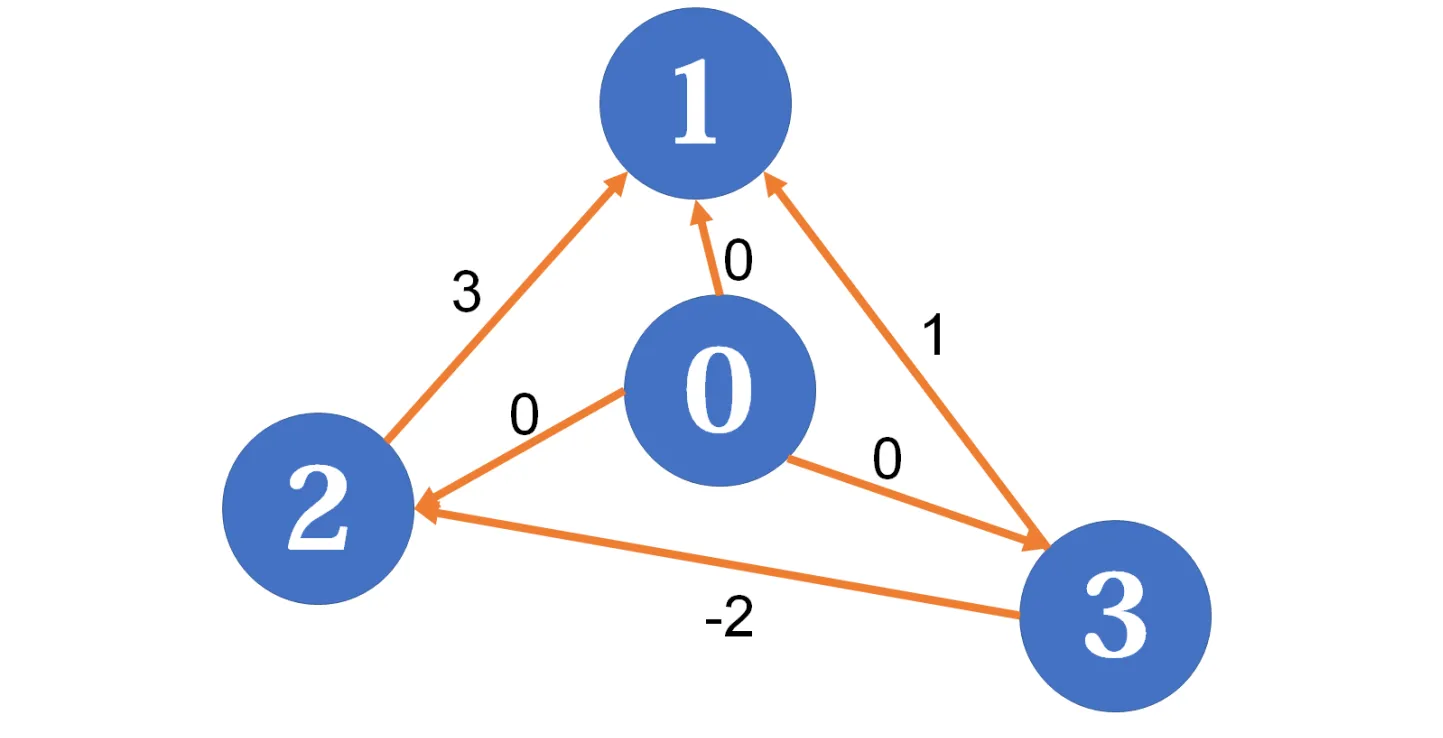部分内容来自差分约束 - 知乎
一、简介
差分约束系统是一种多元一次不等式组( y_1,\ y_2 ,...,y_n 为已知量):
其中,每个不等式称为一个约束条件,都是两个未知量之差小于等于某个常数。
很多题目会给出(或隐性地给出)一系列的不等关系,我们可以尝试把它们转化为差分约束系统来解决。
二、中心思想
我们设 $x_1-x_2\le c$,移项可得 $x_1\le x_2 + c$。
观察这个不等式与最短路问题中的三角形不等式 $\text{dist}[u]\le \text{dist}[v]+w_{v,u}$ 的相似之处,可以发现,我们可以把它转化为一个图论问题。也就是说,对于每一个 $x_{c_i}-x_{c_i'}\le y_i$,我们都从 $c_i'$ 到 $c_i$ 建一条边,边权为$y_i$.
这样建出的有向图,它的每个顶点都对应差分约束系统中的一个未知量,源点到每个顶点的最短路对应这些未知量的值,而每条边对应一个约束条件。

既然是最短路,那么我们应该选取哪个点作为源点?事实上,选取哪个点作为源点是无关紧要的。但是,我们得到的图不一定是连通的,为了避免出现结果为 $INF$ 的情况,我们可以人为增加一个超级源点。
例如,我们现在人为新增一个 $0$ 号点,从它向所有顶点连一条遍权为 $0$ 的边:

现在我们以$0$号点为源点求最短路即可。注意,这相当于添加了以下约束条件:
$$\begin{cases}x_1-x_0\le 0\\x_2-x_0\le 0\\x_3-x_0\le 0\end{cases}$$
由于 $x[0]$ 对应的是 $dist[0]$ ,而 $dist[0] = 0$ ,可知所有未知量均小于等于0(反映在图形上是所有点的最短路均小于等于0)。但实际上我们往往要的是非负解。根据简单线性代数原理可知,在符合差分约束系统的一组解上加上或减去同一个数,得到的解同样符合原系统。例如,上文例子求得的结果为 $x_1 = 0, x_2=−2, x_3=0$ ,然而 $x_1 = 2, x_2 = 0, x_3 = 2$ 也是一组解。
我们可以把 $dist[0]$ 设为另一个数 $w$ 而不是 $0$(或者把从0号点连向各点的边权设为 $w$ ),那么我们得到的便是满足 $x_1, x_2, ..., x_n \le w$的一组解。实际上,可以证明,它们是满足 $x_1, x_2, ..., x_n \le w$的最大解(每个变量取到能取到的最大值):
假设约束系统存在解,我们知道,给定超级源点的一个偏移量 $d[0]$(即 $d[0]$不一定为 $0$),就能由最短路径树确定差分约束系统的一组解(树上两点间路径唯一确定)。同样的,给定最短路径树上任一个节点的值 $d[v]$,都可以求出超级源点的偏移量 $d[0]$,同样也确定了差分约束系统的一组解。对于从 $0$ 到 $v$ 的任意一条路径 $p(0,v1,v2,...,v_n)$,其所表示的约束式分别为: $x[v_1]-x[0] \le 0, \ x[v_2]-x[v_1] \le w(v_1,v_2), \ ..., \ x[v]-x[v_n] \le w(v_n,v)$。叠加得到 $x[v]-x[0] \le w(p)$,令 $x[0]$ 为确定值 $d[0]$,即 $x[v] \le d[0]+w(p)$, $p$为从 $0$ 到 $v$ 的任意路径。取 $p$ 为 $0$ 到 $v$ 的最短路 $p^*$,就有 $x[v] \le x[0]+w(p^*) \le x[0]+w(p)$。则当 $x[v]=d[0]+w(p^*)$时 $x[v]$取得最大值。
以上证明可能略显繁琐,以下给出一个不严谨的证明:考虑Bellman-Ford算法的过程,在差分约束系统中,假设 $X_0$ 是定死的, $X_1$到 $X_n$在满足所有约束的情况下可以取到的最大值分别为 $M_1,M_2,...,M_n$(当然我们不知道它们的值是多少),解出的源点到每个点的最短路径长度为 $D_1,D_2,...,D_n$。基本的Bellman-Ford算法是一开始初始化 $D_1$到 $D_n$都是无穷大,然后检查所有的边对应的三角形不等式,一但发现有不满足三角形不等式的情况,则更新对应的 $D$ 值。最后求出来的 $D_1$到 $D_n$就是源点到每个点的最短路径长度。如果我们一开始初始化 $D_1,D_2,...,D_n$的值分别为 $M_1,M_2,...,M_n$,则由于它们全都满足三角形不等式(我们刚才已经假设 $M_1$到 $M_n$是一组合法的解),则Bellman-Ford算法不会再更新任合 $D$值,则最后得出的解就是 $M_1,M_2,...,M_n$。可以发现,初始值无穷大时,算出来的是 $D_1,D_2,...,D_n$,初始值比较小时,算出来的则是 $M_1,M_2,...,M_n$。大家用的是同样的算法,同样的计算过程,总不可能初始值大的算出来的结果反而小吧。所以 $D_1,D_2,...,D_n$就是 $D_1,D_2,...,D_n$。
那么如何求满足 $x_1,x_2,...,x_n \ge w$ 的最小解呢?只需要求最长路就行了。最长路满足三角形不等式 $dist[u] \ge dist[v] + w_{v,u}$ ,所以相应的差分约束系统需要把小于等于符号换成大于等于符号。对于Bellman-Ford或SPFA算法来说,只需要初始化为 $-INF$ 而不是 $INF$,然后把比较符号颠倒一下即可。
三、例题
【模版】差分约束算法
题目描述
给出一组包含$m$ 个不等式,有$n$个未知数的形如:
$$ \begin{cases} x_{c_1}-x_{c'_1}\leq y_1 \\x_{c_2}-x_{c'_2} \leq y_2 \\ \cdots\\ x_{c_m} - x_{c'_m}\leq y_m\end{cases}$$
的不等式组,求任意一组满足这个不等式组的解。
输入格式
第一行为两个正整数$n,m$ ,代表未知数的数量和不等式的数量。
接下来$m$行,每行包含三个整数$c,c',y$,代表一个不等式$x_c-x_{c'}\leq y$。
输出格式
一行, $n$个数,表示$x_1 , x_2 \cdots x_n$的一组可行解,如果有多组解,请输出任意一组,无解请输出NO。
样例 #1
样例输入 #1
3 3
1 2 3
2 3 -2
1 3 1样例输出 #1
5 3 5样例解释
$\begin{cases}x_1-x_2\leq 3 \\ x_2 - x_3 \leq -2 \\ x_1 - x_3 \leq 1 \end{cases}$
一种可行的方法是$x_1 = 5, x_2 = 3, x_3 = 5$。
$\begin{cases}5-3 = 2\leq 3 \\ 3 - 5 = -2 \leq -2 \\ 5 - 5 = 0\leq 1 \end{cases}$
数据范围
对于$100\%$ 的数据,$1\leq n,m \leq 5\times 10^3$,$-10^4\leq y\leq 10^4$,$1\leq c,c'\leq n$,$c \neq c'$。
评分策略
你的答案符合该不等式组即可得分,请确保你的答案中的数据在 int 范围内。
如果并没有答案,而你的程序给出了答案,SPJ 会给出 There is no answer, but you gave it,结果为 WA;
如果并没有答案,而你的程序输出了 NO,SPJ 会给出 No answer,结果为 AC;
如果存在答案,而你的答案错误,SPJ 会给出 Wrong answer,结果为 WA;
如果存在答案,且你的答案正确,SPJ 会给出 The answer is correct,结果为 AC。
例程
import java.util.*;
public class Main {
public static final int N = 5010;
public static int index = 0;
public static int[] h = new int[N];
public static int[] dist = new int[N];
public static List<Edge> list = new ArrayList<>();
public static int[] count = new int[N];
public static class Edge {
public int to;
public int value;
public int next;
public Edge(int to, int value, int next) {
this.to = to;
this.value = value;
this.next = next;
}
}
public static class Point implements Comparable<Point> {
public int index;
public Point(int index) {
this.index = index;
}
@Override
public int compareTo(Point p) {
return Integer.compare(dist[this.index], dist[p.index]);
}
}
public static void add(int from, int to, int value) {
list.add(new Edge(to, value, h[from]));
h[from] = index++;
}
public static int spfa(int start, int end, int n) {
Arrays.fill(dist, Integer.MAX_VALUE);
dist[start] = 0;
Queue<Point> queue = new PriorityQueue<>();
queue.add(new Point(start));
count[start] ++;
while (!queue.isEmpty()) {
int t = queue.poll().index;
for (int j = h[t]; j != -1; j = list.get(j).next) {
Edge e = list.get(j);
if (dist[e.to] > dist[t] + e.value) {
dist[e.to] = dist[t] + e.value;
queue.add(new Point(e.to));
count[e.to]++;
}
if (count[e.to] >= n) {
return -2;
}
}
}
if (dist[end] == Integer.MAX_VALUE) {
return -1;
}
return 0;
}
public static void main(String[] args) {
Arrays.fill(h, -1);
Arrays.fill(count, 0);
Scanner scanner = new Scanner(System.in);
int n = scanner.nextInt();
int m = scanner.nextInt();
while (m-- != 0) {
int to = scanner.nextInt();
int from = scanner.nextInt();
int value = scanner.nextInt();
add(from, to, value);
}
for (int i = 1; i <= n; i++) {
add(0, i, 0);
}
if (spfa(0, n, n) != 0) {
System.out.println("NO");
return;
}
for (int i = 1; i <= n; i ++) {
System.out.printf("%d ", dist[i]);
}
}
}种树
题目背景
一条街的一边有几座房子,因为环保原因居民想要在路边种些树。
题目描述
路边的地区被分割成块,并被编号成$1, 2, \ldots,n$。每个部分为一个单位尺寸大小并最多可种一棵树。
每个居民都想在门前种些树,并指定了三个号码$b$,$e$ ,$t$ 。这三个数表示该居民想在地区$b$ 和$e$ 之间(包括$b$ 和$e$)种至少$t$ 棵树。
居民们想种树的各自区域可以交叉。你的任务是求出能满足所有要求的最少的树的数量。
输入格式
输入的第一行是一个整数,代表区域的个数$n$。
输入的第二行是一个整数,代表房子个数$h$。
第$3$ 到第$(h + 2)$ 行,每行三个整数,第$(i + 2)$ 行的整数依次为$b_i, e_i, t_i$,代表第$i$ 个居民想在$b_i$ 和$e_i$ 之间种至少$t_i$ 棵树。
输出格式
输出一行一个整数,代表最少的树木个数。
样例 #1
样例输入 #1
9
4
1 4 2
4 6 2
8 9 2
3 5 2样例输出 #1
5数据规模与约定
对于$100\%$ 的数据,保证:
-$1 \leq n \leq 3 \times 10^4$,$1 \leq h \leq 5 \times 10^3$。
-$1 \leq b_i \leq e_i \leq n$,$1 \leq t_i \leq e_i - b_i + 1$。
解析
使用前缀和,那么题目给出的条件就可以被转化为 $S[E]−S[B−1] \ge T$ 。但仅仅是这样是不够的,还要注意到,题目要求每一块上只能种一棵树,所以我们有 $0 \le S[i+1]−S[i] \le 1$,以这些约束条件建图求最长路就可以解决了。
例程
import java.io.BufferedReader;
import java.io.IOException;
import java.io.InputStreamReader;
import java.io.StreamTokenizer;
import java.util.*;
public class Main {
public static final int N = 30010;
public static int index = 0;
public static int[] h = new int[N];
public static int[] dist = new int[N];
public static List<Edge> list = new ArrayList<>();
public static class Edge {
public int to;
public int value;
public int next;
public Edge(int to, int value, int next) {
this.to = to;
this.value = value;
this.next = next;
}
}
public static class Point implements Comparable<Point> {
public int index;
public Point(int index) {
this.index = index;
}
@Override
public int compareTo(Point p) {
return Integer.compare(dist[p.index], dist[this.index]);
}
}
public static void add(int from, int to, int value) {
list.add(new Edge(to, value, h[from]));
h[from] = index++;
}
public static void spfa(int start) {
Arrays.fill(dist, -1);
dist[start] = 0;
Queue<Point> queue = new PriorityQueue<>();
queue.add(new Point(start));
while (!queue.isEmpty()) {
int t = queue.poll().index;
for (int j = h[t]; j != -1; j = list.get(j).next) {
Edge e = list.get(j);
if (dist[e.to] < dist[t] + e.value) {
dist[e.to] = dist[t] + e.value;
queue.add(new Point(e.to));
}
}
}
}
public static void main(String[] args) throws IOException {
Arrays.fill(h, -1);
Read read = new Read();
int n = read.nextInt();
int m = read.nextInt();
while (m-- != 0) {
int b = read.nextInt();
int e = read.nextInt();
int t = read.nextInt();
add(b - 1, e, t);
}
for (int i = 1; i <= n; i++) {
add(0, i, 0);
if (i != n) {
add(i + 1, i, -1);
add(i, i + 1, 0);
}
}
spfa(0);
System.out.println(dist[n]);
}
}
class Read {
StreamTokenizer streamTokenizer = new StreamTokenizer(new BufferedReader(new InputStreamReader(System.in)));
public int nextInt() throws IOException {
streamTokenizer.nextToken();
return (int) streamTokenizer.nval;
}
}